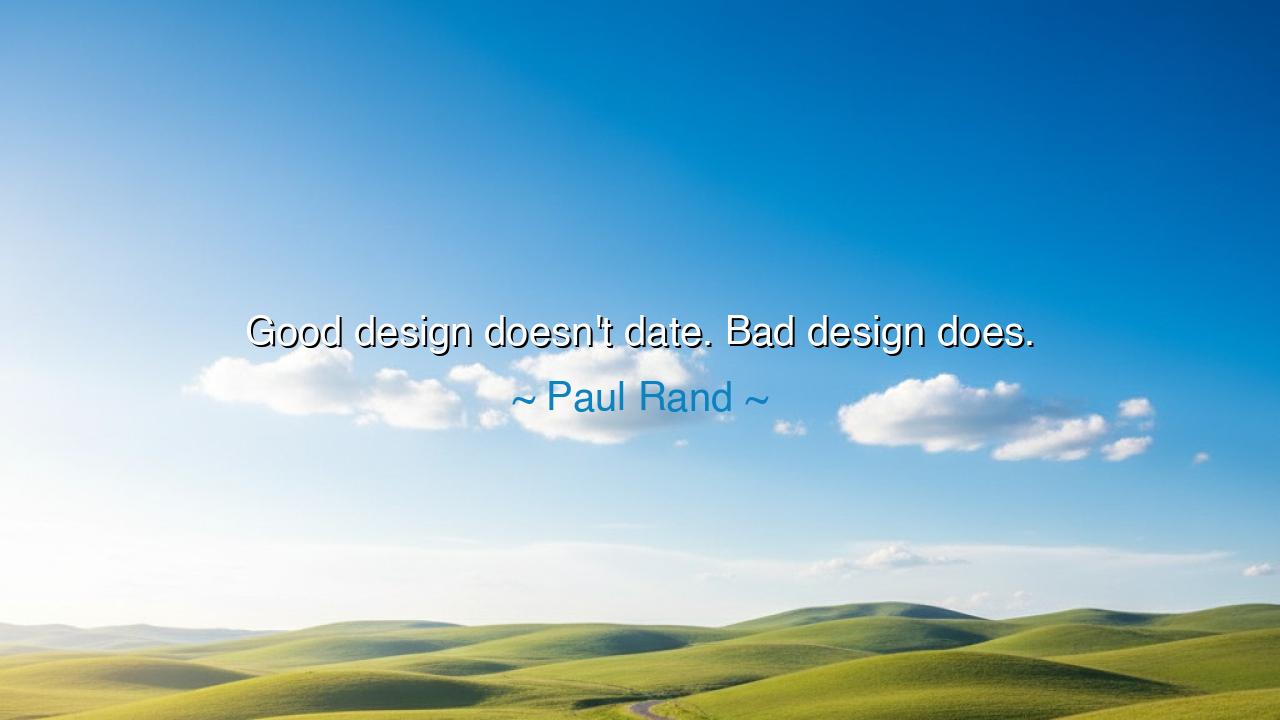
Good design doesn't date. Bad design does.






“Good design doesn’t date. Bad design does.” Thus spoke Paul Rand, the wise craftsman of symbols, whose hand shaped the emblems of great enterprises — IBM, ABC, UPS — marks that endure not merely because of their beauty, but because of their truth. His words are not only about logos or layouts, but about the eternity of harmony, the permanence of that which is made with integrity. Rand’s teaching is the teaching of all the ages: that what is born of essence and clarity will stand through time, while what is born of vanity or haste will decay like paint left to weather.
To the ancients, this truth was already known. The architects of Greece and Egypt did not design for the fashion of the day, but for the order of the cosmos. The Parthenon still stands because it was not made to please a passing eye; it was made in reverence to proportion, balance, and purpose — the holy trinity of design. The pyramid does not grow old, for it holds the geometry of eternity. Yet countless temples and towers built in later ages, adorned with excess or ego, crumble not from stone’s weakness but from the frailty of their intention. The same holds true in all arts: what is designed well endures, because it aligns with the deeper rhythm of existence.
Paul Rand saw this eternal law in the modern world of commerce and color. He understood that good design is not decoration — it is communication, distilled to its purest form. When he crafted the IBM logo, he stripped away ornament, leaving only strength and clarity. It was not “modern” merely because it was new; it was timeless because it was honest. “Good design doesn’t date,” he said, for it rests on principles that do not change: balance, simplicity, unity. But “bad design does,” for it chases novelty instead of truth, surface instead of soul.
Consider the story of Steve Jobs and the birth of Apple. Jobs, who studied design through the lens of calligraphy and Zen, was deeply inspired by Rand’s philosophy. He understood that beauty was not style but integrity — that a product, like a temple, must have purpose in every line and proportion. The first Macintosh, the iPhone, the very Apple logo itself — these were not trends, but embodiments of simplicity. Jobs once said, “Design is not just what it looks like and feels like. Design is how it works.” He, like Rand, believed that when something is true to its function, it becomes eternal.
The ancients would have recognized this as the law of harmony — the balance between form and purpose, between appearance and truth. What is made without harmony, no matter how beautiful for a season, withers when the fashion fades. But what is made with harmony — whether a song, a house, or a way of life — becomes a companion of time. The sculptor Phidias, the poet Homer, the painter Da Vinci, the craftsman Rand — all drank from the same well: they sought to capture essence, not moment. Their works remain not because they were new, but because they were true.
Thus, the quote is not about design alone, but about how we live and create. Every choice we make — in our work, our speech, our relationships — is a kind of design. If our actions are built upon shallow motives, they will date quickly; they will wither in memory like fashions of the heart. But if they are grounded in honesty, clarity, and purpose, they will endure. To design one’s life well is to live in alignment with what is real — not what is fleeting.
Let this be your lesson, seeker of meaning: do not chase the new for its own sake. Seek instead the timeless. Whether you build, write, speak, or love — build with simplicity, act with sincerity, shape with care. Ask yourself, Will this still be true when I am gone? Will this still carry light when the world has changed? That is the test of good design, and of a good life.
For in the end, as Paul Rand reminds us, time is the final critic. The years will strip away all that is false, leaving only what was built with wisdom and integrity. Good design — in art, in work, in being — does not age; it becomes part of eternity. Bad design, born of haste and ego, fades into dust. Therefore, design not for the hour, but for the ages. For what is true will never grow old.






AAdministratorAdministrator
Welcome, honored guests. Please leave a comment, we will respond soon